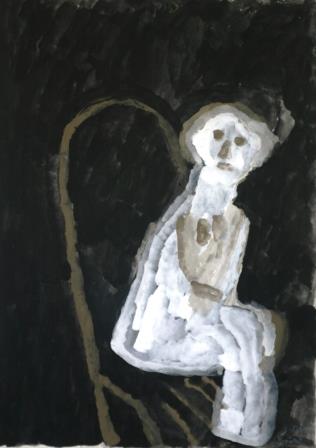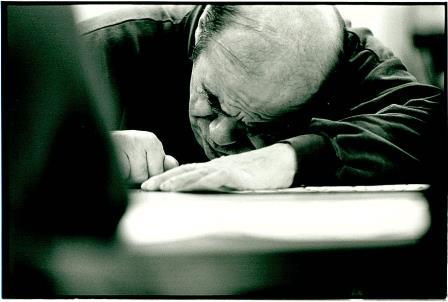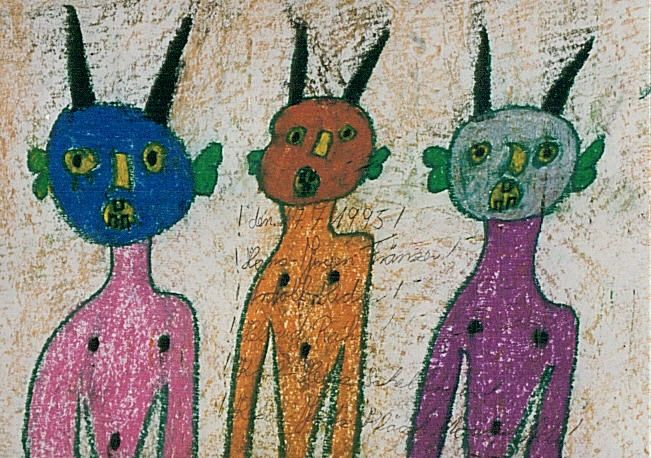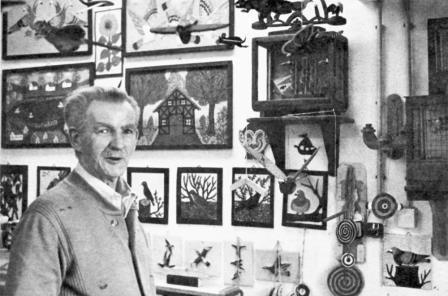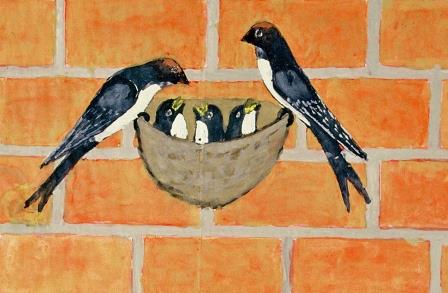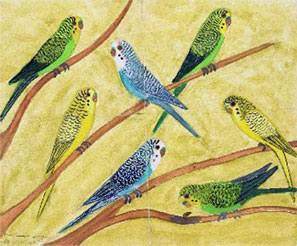Works of Art from the Kunsthaus Kannen collection
Duration: 14. July till 22. September 2013
Opening: Sunday 14. July, 15 p.m.
Artists: Fritz Tobergte (1913-1989), Bruno Ophaus (1920-1991), Josef König (1930-1996), Hans- Jürgen Fränzer (1942-2011) and Karl Cornelius (1924 -1989)
On the occasion of the 125. anniversary of the Alexianer Münster the sequel of the exhibition „Works of art from the Collection“ offers five artist with different creative styles, but a common love for expressing and fullfilling themselves: Fritz Tobergte (1913 – 1989), Bruno Ophaus (1920 – 1991), Josef König (1930 – 1996), Hans-Jürgen Fränzer (1942 – 2011) and Karl Cornelius (1924 – 1989). Fritz Tobergtes artworks are a jigsaw puzzle out of various interwoven lines and flourishing, which mirror everyday-life objects like suns, people, animals and buildings. The pictures are going to be supplemented with a range of handwritten texts, which mainly deal with songs and prayers. In comparison Bruno Ophaus captures his varied and always clear motifs, like people and animals, often in series of accumulations spread over the entire surface, in which his figures resemble each other. On the other hand Josef König is working completely different. His drawings are populated with small budding forms, which are placed regularly over the entire surface and join together in meditative wickerwork of forms, lying beyond any illustration. Though as a stark contrast the works of Hans-Jürgen Fränzer standing there, whose figures and objects are „screaming out“ like (catch-)phrases: determining, ruthless, remaining for their own without a reference to each other, occasionally alarming and provoking, without comment, monopolizing. A far relieved tone is pronounced in the colorful pictures and objects of Karl Cornelius. His motifs are often taken from daily observations and impressions. These are depicted from the artist in objects like ships, windmills, mechanically appearing ferris wheels or animal-constructions. In partly curious, but always powerful-creative diversity and expression the exhibition is going to be adapt the situation of the artist’s atelier.
The <link fileadmin user slg._2press-release.pdf>Press Release can be downloaded here
Artists
Fritz Tobergte (1913-1989)
Fritz Tobergte lived from 1935 to 1989 on the site of Alexianer Münster. His pictures are a jigsaw puzzle out of various interwoven lines and flourishing. The observer can find people, encounters between different kinds of people, churches and images of Jesus Christ with a crown of thorns and stigmata. He also uses fragments of prayers or chants to illustrate his works. The artist often brings together elements that do not seem to be compatible at first glance and combines them through his personal logic to his works. Conspicuous are the scattered texts, for the most part song texts and prayers, but also numerous quotations and fragments, whose meaning is not always to decode.
Bruno Ophaus (1920-1991)
Bruno Ophaus' first attempts at drawing were in 1983, when he had been living in Haus Kannen for 40 years. He was one of the first patients to participate in art therapy. In the 10 years up to his death he went through an astonishingly creative phase, which is reflected in the variety of his pictorial statements. He began in 1984, copying from other pictures. He took many different animal forms, from dinosaurs to various ducks, from animal books. The pictures tell stories by means of the accumulation, transformation, direction, repetition and colour of his animal and human forms. His delicate drawings now and then show memories of his hometown, Südkirchen. His drawings, in pencil and felt-tip, reflect his former profession as a builder, with their village squares, walls, hobs and wheelbarrows.
Josef König (1930-1996)
From 1971 to 1996 Josef König lived on the site of Alexianer. Paper after Paper, immersed in an extremely precise care Josef König paints his pictures and puts his entire devotion into the process of creation. The fact that Josef König was deaf and dumb increases the value of this expressive outlet immensely. The artist’s compositions of color haves a forceful signal effect. They lay beoynd any illustration and appear because of the minimal use of forms and colors more like meditative reports. Josef König puts short lines of wax crayon dense next to each other until the paper is entirely covered with a thick, monochrome or two-colored color-layer. These layers of strokes provide a flaming and surging character. In another step circles of various sizes were lined up one after the other, and then all crayoned over in a layer of glowing colour. By doing this small dubbing forms were created, placed regularly over the entire surface and join together in wickerwork of forms. They start in the void and end in the middle of the milling mass interwoven to microcosms.
Hans-Jürgen Fränzer (1942-2011)
Since 1970 Hans Jürgen Fränzer lived in a communal residence of the Alexianer Münster. His pictures came quickly into being, determined and ritual. They live on an astonishing immediacy and uncompromisingness. His colors are shrill and poster-like, his texts are domineering and added with exclamation marks. The formats are taken till the edges, the motifs are centered. The stiff figures are mostly directly turned to the viewer. Hans-Jürgen Fränzer subjects are those who moved (not only) his world: money, cigarettes, football, universe, people, animals. The artist uses figures and objects like (catch-)phrases, “screaming out” from his works: determining, ruthless, remaining for their own without a reference to each other, occasionally alarming and provoking, without comment, monopolizing. Their depiction is coarse, expressive and without any detail. Once he carried out something, he never corrects or improves it. There’s no space for sentimentality or discretion.
Karl Cornelius (1924-1989)
Karl Cornelius attracted people's attention during occupational therapy through his pure and imaginative wood-carvings. It was possible to provide him with a workshop in 1983, which he quickly adorned with his carvings and paintings. Karl Cornelius didn't speak much, but because of his well-balanced, friendly personality, he enjoyed a good relationship with his fellow residents and therapists. In his original way, he constructed and formed wooden toys, marble track games, rocking animals, ships, birds and aeroplane mobiles, often in his own design. He liked to give his objects away as presents. Karl Cornelius kept several finches and canaries in cages he had made himself. He became increasingly interested in painting, in which he used to copy from books and illustrations.




